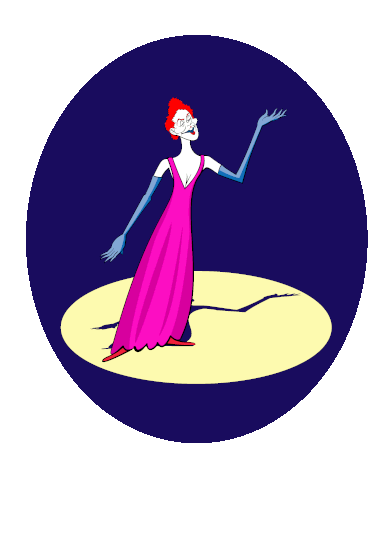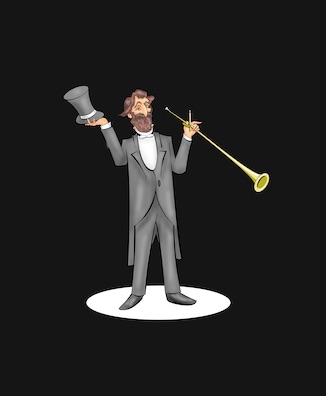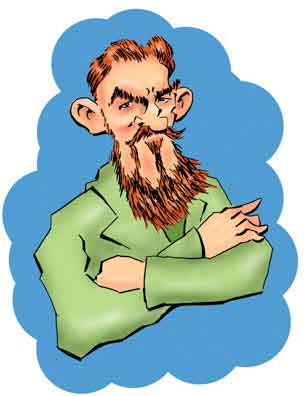Yvette Guilbert
(Click to Zoom In and Out)

Pretty much everyone knows about the Moulin Rouge - the "Red Mill". That's the famous cabaret and nightclub in the Montmartre district of Paris.1 It was established in 1889 and is still up and running aujourd'hui.
Students of the time and place know that some of the patrons and performers therein came to sad ends. Henri de Toulouse-Lautrec, for all his fame as an artist, ultimately landed in a mental hospital and then died in 1901 at age 36. The can-can dancer Louise Weber, known as La Goulue2 ("The Glutton"), ended her days living in a run down trailer and died old, overweight, and forgotten in 1929. Even Jean Avril, who led by no means the most tragic life, died in poverty in occupied Paris in 1943.
Footnote
The Moulin Rouge (pronounced moo-lah ROOZHE) was also the name of the first integrated hotel and casino in Las Vegas. Among the owners was boxing champion Joe Louis. The casino and hotel was opened in late May, 1955 and closed six months later.
Then there's Yvette Guilbert.3 She was born in Paris in 1865 and for a while it looked like she might have a fairly comfortable childhood since her mom, Albine, had started a hat business that showed promise. Her dad, Hippolyte, was also a businessman but not as savvy as his wife. Not able to stand being a failure when his wife was successful, Hippolyte skinned out when Yvette was 13. Although Hippolyte hadn't been much of a businessman he did at least bring in some income and Albine and Yvette found themselves in tight circumstances.
Yvette began working as a salesgirl in the local shops and also worked as a model for the artists that at the time were pretty common around Paris. But she had higher aspirations. There were plenty of small not quite respectable cabarets around, not just in Paris, but throughout France. There aspiring performers could get up on a stage and sing or deliver monologues (and stand-up comedy was called) depending what they wanted to do. If they became popular with the crowds the owners might hire them as a regular.
Yvette - her real name was Emma - was not an immediate hit. In fact, in her first performances she was hooted off the stage. It was less the music than her appearance. She just didn't look like the typical beauty that the largely masculine audiences expected in the girls. Instead Yvette was tall and willowy without the hour-glass Gibson girl figure so popular in the fin-de-siécle.
But she could sing and eventually her talent began to win over the audiences. Also she decided to accentuate her unique appearance by applying white make-up and dying her hair bright red. She also began wearing long loose dresses and what became her trademark, long arm-length black gloves.

Henry
Yvette didn't care for his portraits.
Henry probably met Yvette around 1893. At least it was about that time that Yvette asked Henry if he would make a poster for her. Henry seldom refused doing favors for friends. Yvette herself said she first met Henry when one of her song-writing friends brought Henry to her house for lunch. Although Henry did make a number of drawings and paintings of her, she wasn't always pleased with them.
Yvette's songs are often described as being delivered in a semi-spoken/semi-sung style. From her extant recordings that seems be a fair description and she certainly sings with a lot of rubato with perhaps a bit more singing than speaking.
Her specialty - popular in 19th century Paris - was the chanson. These are songs about the local life among the hoi polloi 4 around Montmarte. For the proper Victorians the lyrics were not only suggestive but downright risqué.
Footnote
Yes, yes. We realize hoi polloi means "the people" (Greek: οἱ πολλοί). So when we refer to THE hoi polloi, we're actually saying "the the people". But that's the way it goes.
Yvette's performing style was unique. Rather than moving around on stage, she stood still only gesturing with her arms. Her singing voice was contralto and rather earthy. Soon she was attracting the notice not of just the Parisian locals but also visitors from abroad including the playwright George Bernard Shaw and Augustine Charcot who was the wife of the famous neurologist Jean-Martin Charcot. Of course, on one of Jean-Martin's most famous students was Sigismund Schlomo Freud, who most people now call Sigmund. Siggy became a friend and naturally he had to psychoanalyze Yvette based on her songs. Of course, Yvette thought his analyses were très merdique. But they stayed pretty good friends nonetheless.
Fans of Yvette ...

...Guiseppe...

... and Sigmund ...

... and George.
It wasn't just "pop" fans that came to see her. The composers Charles Gounoud (Faust, Funeral March of a Marionette5) and Guiseppe Verdi (Aida) heard her sing. We see, then, that Yvette's contacts were men and women of influence and this was certainly a factor in her avoiding the sad fate of some of her contemporaries.
In 1897 Yvette married a biologist from Vienna turned show business manager. That was Max Schiller. Although show-biz marriages are often as durable as a politician's promises, evidently Max and Yvette had a happy enough union and it lasted decades.
And far better than many of her contemporaries, Yvette managed the change from the late 19th century (when music had to be live) to the era of commercial recordings and motion pictures (yes, she did appear in some films). Her fame grew and she toured Europe and America. Among those who attended her performances were King Edward VII, Queen Victoria's somewhat devil-may-care and rather hefty son. While in New York she sang in Carnegie Hall (she spoke fluent English) although when she translated her songs for English audiences she toned down some of the lyrics.
A major bump in her career was in 1899 when she underwent an operation. Possibly the tight-waisting garments of the time had damaged a kidney which had to be removed. In any case she decided to slow down a bit and began studying medieval and other French folk songs. She soon became a recognized authority on French musical history and in 1932, she was awarded the Legion of Honor. Perhaps a greater honor was to have a biography in the Encyclopedia Britannica while she was still alive. Elvis wasn't even mentioned in the 1957 edition of The World Book.
We mentioned Yvette's husband, Max, was from Austria and they spent considerable time in Europe's German speaking states. But as the 1930's rolled in, times took on an ominous turn. Then when the Germans invaded France in 1940, things became dire since Max was Jewish.
Yvette and Max - neither of whom was getting younger - escaped to Aix-en-Provence which was as far from Paris as you could get without leaving the country. Although the southern part of France was nominally independent, it remained an ally of Germany and initiated its own anti-Jewish laws. However, Yvette and Max remained in southern France and were relatively undisturbed. It was there in January 1944 that Yvette died at age 79.
References and Further Reading
"Yvette Guilbert", Encyclopedia.com.
"Yvette Guilbert", Encyclopedia Britannica.
Yvette Guilbert: Struggles and Victories, Yvette Guilbert, Mills and Boon, 1910.
"Who Was Yvette Guilbert? My Paris", Kate Marilley (actor), Long Wharf Theater, New Haven, Connecticut, April 26, 2016.
"Yvette Guilbert", Lyrics Translate.
"Yvette Guilbert", Discography of American Historical Recordings
That Was Yvette: The Biography of the Great Diseuse, Bettina Knapp and Myra Chipman, Holt, Rinehart and Winston, 1964.
"This Was Not Yvette", Simon Raven, The New York Review, April 22, 1965
"Women in the Music Hall", Into the Limelight.
"Bizarre Denizens Of Lautrec's World; Yvette Guilbert, Jane Avril, La Goulue, et al., Make Up an Imperishable Semimonde of Art., The New York Times, February 2, 1964.
Toulouse-Lautrec - A Life, Julia Frey, Viking, 1994.